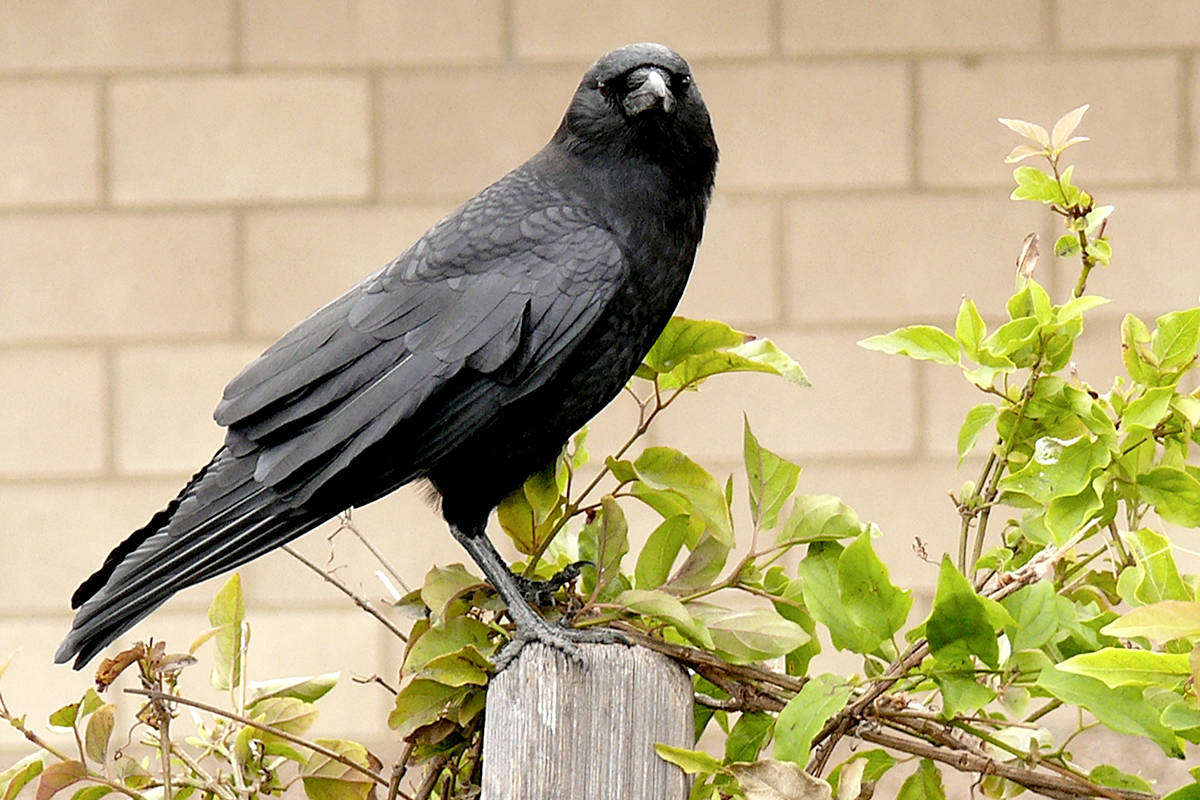They’re underestimated, abused and generally not well liked.
Yet, they’re the Einsteins of North America’s bird world. At least that’s how a Shuswap wildlife biologist describes them.
Di Wittner has worked with 200 species of birds over the past 30 years and has rescued hundreds of crows.
When she refers to Einstein, she is referring to the corvids – the family of birds that includes crows, ravens and jays.
Crows are able to learn exceptionally quickly and they clearly know what joy is, she explains.
“It’s documented they do things just for fun,” Wittner says, giving the example of a video where a crow uses a metal lid and skis down a steep roof, then goes back up and does it again.
It’s also been documented that crows can recognize faces. Wittner points to a study in Guelph, Ont. where students wearing a particular mask would harass the birds. The crows became very upset and learned quickly to recognize the mask as a threat, sending off alarms and attacking it if it walked through the grounds.
Similarly, crows have been found to recognize the faces of people who have been kind to them.
Crows can do tasks and tricks, like counting lids to find food under them, or learning about water displacement by dropping stones into a glass of water in order to raise the water level so they can reach a floating nut.
Like ravens, they can use tools to accomplish tasks.
Recently on a Salmon Arm street they could be seen dropping walnuts from hydro poles in order to crack the shells. They’ve also been known to drop rocks on nuts or shellfish to crack the shells.
“They’re extremely bright birds,” says Wittner.
Despite that – or maybe because of it – crows are regularly mistreated by humans.
“Most intelligent birds are the least liked by humans because they don’t like to be outsmarted by birds,” Wittner surmises.
She has seen more than her share of cruelty to crows.
She’s seen them shot with pellets and left to die, snared with wire, tortured.
Farmers sometimes hate them because of their love for corn, but among their favourite foods are grasshoppers and cutworms, whose demise can help farmers’ crops.
Read more: 2016 - Stop the deliberate killing of crows in the Shuswap
Read more: 2016 - Crows have tremendous value to our ecosystem
They’re a very social animal, which is why they are usually seen in flocks. Ravens, on the other hand, are solitary.
“When crows come across a dead member of their species, it’s quite a deal, they raise quite a ruckus. A hawk would keep going, but crows stop to figure out what’s going on.”
She’s not sure whether it’s from grief or alarm, but she is pretty certain they grieve their own family members.
If they can feel joy, they likely feel grief – as many birds show, Wittner says.
“Lots of birds get extremely distraught if something happens to their young. They all have that, we just don’t know how long that sense of loss lasts,” she says. “Having been a biologist for 30 years and working one on one, I’ve seen grief in a number of birds, not just crows. It can be really hard to watch actually.”
It’s not unusual for crow families to stick together – sometimes a yearling crow will stay with its parents to help rear the next batch.
And how to tell the difference between a crow and a raven?
One way is size – a crow weighs a lot less than a raven. A crow has a square-shaped tail while a raven’s is wedge-shaped. A crow has a smooth curve on the top of its beak, almost straight. A raven has a heavier, bigger, curved beak, more of a hook.
And their voices are very different. While a crow goes ‘caw, caw,’ a raven has more of a ‘goink, goink’ sound. A lot of times in horror movies, you’ll hear raven vocalizations, Wittner explains.
Ravens are better flyers and can go farther, faster. A crow’s normal lifespan is from 10 to 20 years, while a raven can live to 50.
Wittner thinks people misjudge crows because they’re common and not colourful – not beautifully flashy like a red-tailed hawk, for instance.
Fear-mongering adds to it. There’s talk of crows and ravens taking out the eyes of a young calf, but that’s very rare, she says.
“A lot of this is myth.”
Ed McDonald, president of the Shuswap Naturalists, agrees.
“Crows are often bad-mouthed as they steal the eggs from other nests – people don’t realize that’s part of nature, they have to eat too. They also clean up a lot of stuff around roads, animal kill… They’re very good for cleanup and you will find them at landfills.”
Wittner notes that people also eat eggs.
“Because crows will eat anything that’s edible, it probably makes them unpopular,” she says.
“They really are a respect-worthy species. I think we do ourselves a disservice if we vilify them and say those are bad birds. They’re not bad birds.”
@SalmonArm
marthawickett@saobserver.net
Like us on Facebook and follow us on Twitter
